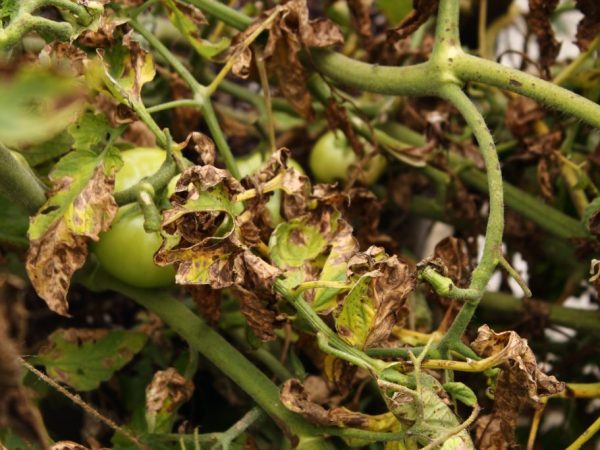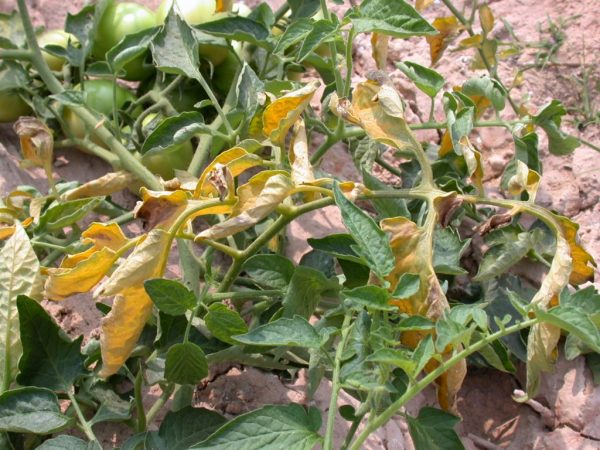Treatment of fusarium wilt of tomatoes
Long-term cultivation of a tomato crop in the same section of the greenhouse without a timely change of soil often leads to the fact that fusarium wilt of tomatoes begins to develop. The disease can also become a threat to tomatoes grown outdoors.

Treatment of fusarium wilt of tomatoes
The disease can manifest itself at any stage of cultural development. However, the peak activity of the pathogen is observed during fetal formation. The reason for this is the drop in tomato immunity.
Characteristics of the disease
Fusarium wilt of tomatoes is a disease that is caused by a fungus called "Ruzarium". In order to properly deal with it and not endanger your harvest, the gardener should know the following main points:
- Ways of plant infection.
- A symptomatic picture that allows you to recognize the disease.
- Control methods and preventive measures.
Having a full range of information, a person can more easily cope with those problems that provoke the disease process and save not only the current generation of tomatoes, but also many subsequent ones.
How the pathogen enters the sprout
The fungus, which is the causative agent of a tomato disease such as fusarium, enters the plant through a young root system and develops from the bottom up. That is why it is worthwhile to properly process the soil before planting seedlings.
In most cases, tomato fusarium in seedlings begins due to the entry of the pathogen through the wounds and the formation of the lateral branches. At first, it is not easy to notice that the plant is unhealthy. The main reason for this lies in the fact that the progress of tomato fusarium occurs simultaneously with the development of seedlings. If measures are not taken in time to solve the problem, the fusarium wilt of tomatoes can spread to the entire area. This can completely destroy the expected harvest.
Disease behavior
Fusarium wilt of tomatoes has a negative effect on the vascular system of tomatoes. The fungus, having got into the root system of the seedlings, begins to clog the vessels, and also gradually releases substances that cause the gradual wilting of the leaves and stem. Ultimately, the plant dies, and the seeds from the fruits of the affected bush become unsuitable for planting in the soil.
If fusarium in young tomato seedlings did not hit the seedling right away, then it can do it while pinching the tomatoes. During this procedure, wounds appear on the plant, through which fungi can enter the sprouts and trigger fusarium wilting. Exposure to toxins will not only lead to wilting of seedlings, but also turn the roots of the plant into dust due to complete dehydration.
Conditions for the development of the fungus
For the development of a disease that affects the tomato crop, certain conditions are needed. Fusarium tomato blight cannot appear on its own and remain in the soil on its own under any conditions.
In order for the fusarium wilt of tomatoes to progress and remain a potential danger to seedlings, the following conditions are needed:
- A sharp change in temperature.
- Insufficient lighting.
- Wet soil (if water stays at the stem for more than 1 hour).
The likelihood of disease progress becomes higher when the temperature did not exceed 14 degrees Celsius during sowing of the seed. The activation of disease processes is observed at a temperature level of 27-28 degrees above zero.
It is also worth remembering that the fungus that causes wilting in tomatoes can be kept for quite a long time in the soil with which the greenhouse is equipped, on the surface of the tools used, tops of plants, fruits and leaves of tomatoes, and even on substrates. The pathogen can persist, being at the stages of mycelium or chlamydospores. Ways of spreading fusarium - soil, water, gardener's tools.
Symptomatic picture

Hot weather will promote the rapid spread of the fungus
Before starting the treatment of tomatoes, it is worthwhile to clearly determine what disease the culture is affected by. In this the gardener will be helped by a set of basic signs that distinguish the wilting of seedlings and more mature tomatoes caused by the fungus "Ruzarium".
The development of symptoms of fusarium occurs from the roots to the top of the plant. The following stages are distinguished signs that the tomato is affected by Fusarium:
- The foliage of the plant becomes pale green or takes on a yellowish tint.
- If a leaf is affected by a disease, its veins become lighter.
- The foliage stalks begin to deform.
- The foliage gradually falls off, having previously twisted.
- Shoots at the top of the seedling or more mature bush begin to wither.
- The tomato eventually dries up and dies.
The most advanced stage of the disease involves the destruction of the root system of the affected bush. Also, the symptomatic picture may include the appearance of a bloom of pink color near the root collar of the tomato affected by the fungus.
Hot weather contributes to the more intense development of the disease and the manifestation of its symptoms. It is important to remember active observation of the symptoms of fusarium disease during the flowering and fruit formation stages. In the same period of culture development, the likelihood of mass destruction of plants increases.
How to overcome the disease
A gardener who wants to consistently receive crops and seed without crop loss should know what fusarium tomato wilting is and what the treatment is. Knowing how to cope with the disease, you can save more than one area planted with tomatoes from certain death.
The disease caused by the fungus and affecting the tomato culture, to the great regret of gardeners, is practically not removed. Therefore, you should not indulge yourself in false hopes by choosing methods to combat wilting.
Prophylaxis
If it is not possible to treat, everything must be done so that diseases cannot develop and infect the culture that is being grown. To save tomatoes from fungal diseases, preventive measures are almost the surest solution.
To date, there are the following preventive measures carried out when planting tomatoes:
- Check seedlings for contamination.
- Use special tools to remove foliage and pinch. To combat the pathogen, it is imperative to decontaminate the instruments with a solution of potassium permanganate or alcohol.
- Avoid removing stepchildren or foliage with your hands.
- Sow seed into pre-warmed soil.
- At the stage of fruit formation, replace nitrogen fertilizers with potash fertilizers.
- Spray the crop area after every rain.
In addition to the proposed measures, preventive methods of combating the fungus include processing the roots of seedlings using a biological solution.Preventive treatment with biological products must be carried out under appropriate conditions, which will enhance the effect of their impact. In order for biological preparations to work effectively and provide the necessary protection, it is necessary to maintain the temperature regime at 18 and above degrees with a humidity of 65-70%.
In order to save plants grown in greenhouse conditions from possible infection, the following actions are usually taken:
- Maintaining a stable air temperature. During the day, it should be 22-24 degrees Celsius. At night, it should be within 16-18 degrees.
- To successfully combat the pathogen, it is important to maintain a stable level of humidity. It is 75-80% during the daytime and 60-65% at night.
- During hot weather, glass surfaces of greenhouses become whitened.
- Avoid excessive moisture in the area with tomatoes.
All these measures cannot be taken for complete treatment. However, their use will prevent the development of the fungus "Ruzarium". This means that it will not get into the root system of young seedlings and will not destroy the culture that is cultivated by gardeners with care and trepidation.
Conclusion
Fusarium tomato wilting treatment is almost impossible. This is influenced by the rarity of its development, and many other factors. To combat the causative agent of the disease, gardeners use many preventive methods. Their timely application and correct use of the land for planting can replace treatment and save crops from certain death.
Remember to take care of plants as well as people. Try to maintain their immunity, monitor their condition. Only in this case, any cultivated crop will please with a good harvest and high-quality seeds for subsequent plantings.


